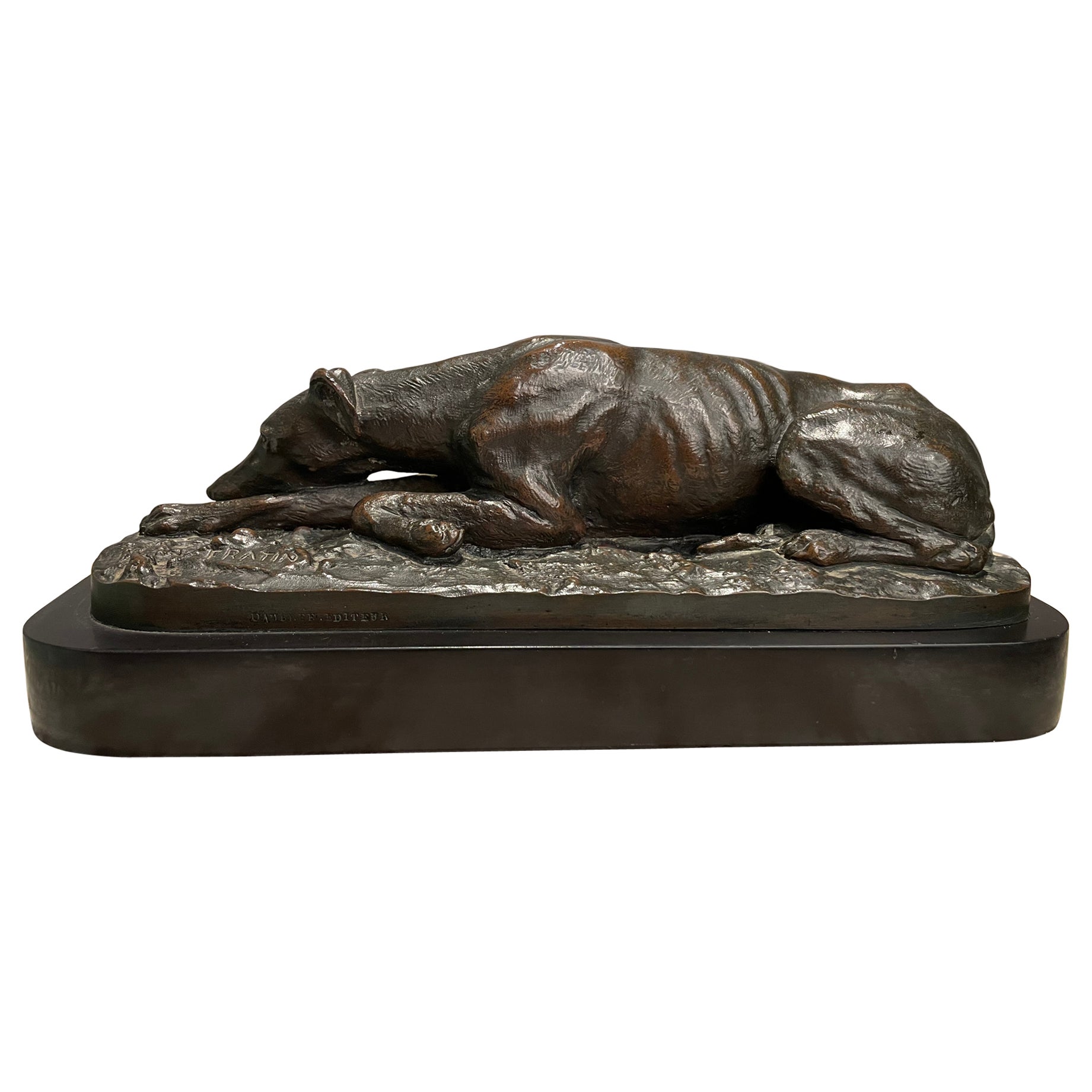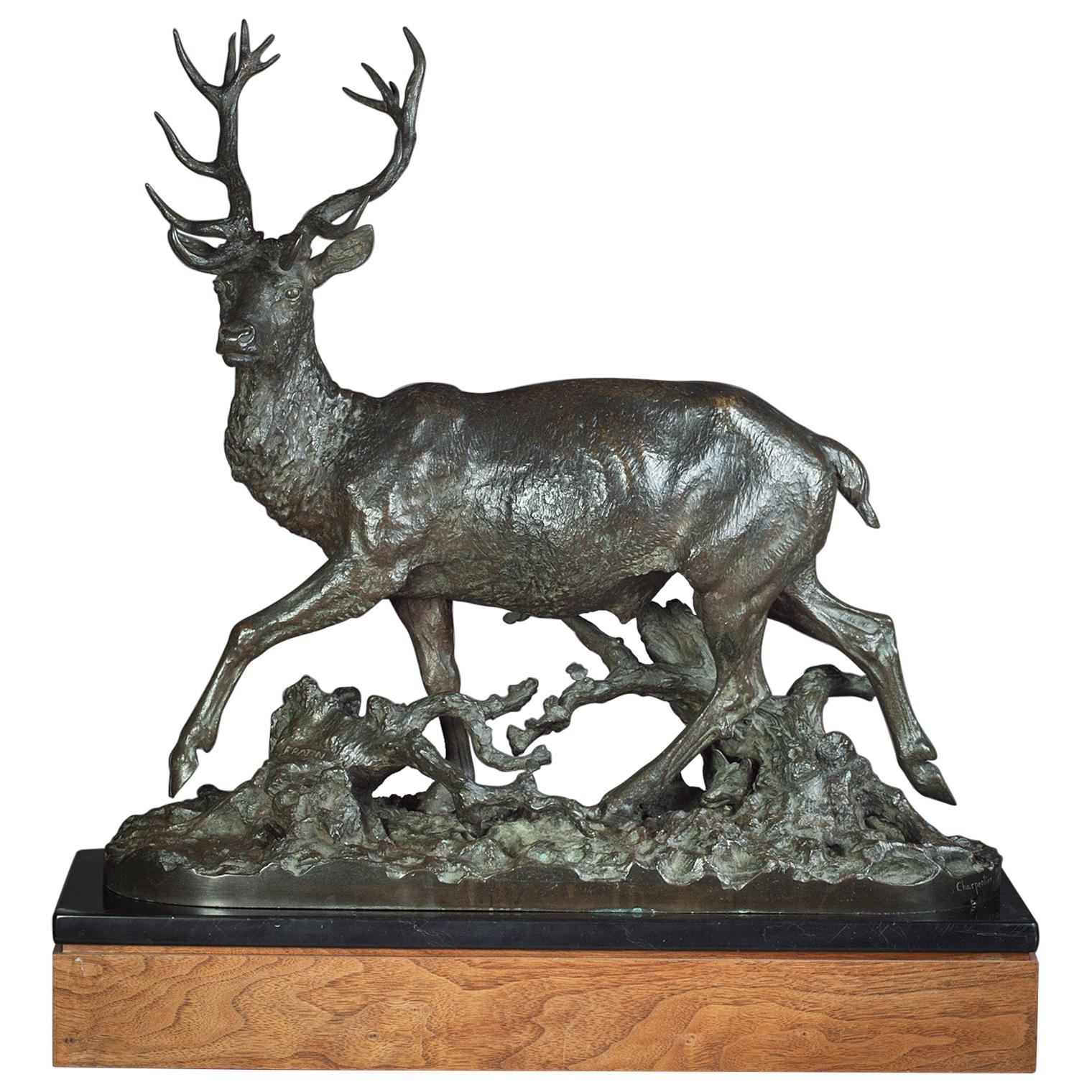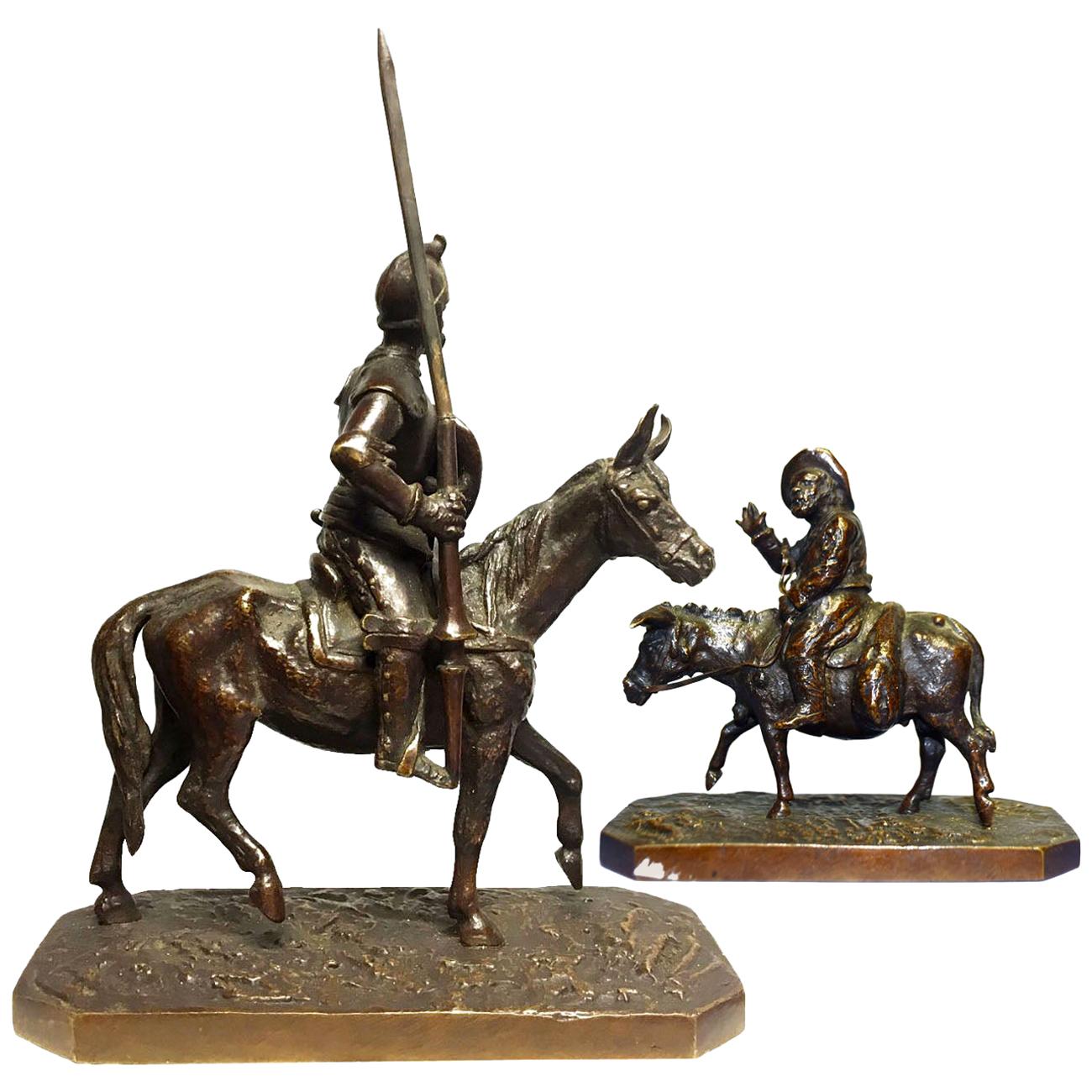Items Similar to French Bronze Sculpture "Reclining Greyhound" by Christophe Fratin, circa 1860
Want more images or videos?
Request additional images or videos from the seller
1 of 14
French Bronze Sculpture "Reclining Greyhound" by Christophe Fratin, circa 1860
About the Item
"RECLINING GREYHOUND" BY CHRISTOPHE FRATIN (FRENCH, 1801-1864)
Signed in naturalistic base "FRATIN", foundry cold-stamped mark along edge "A. DAUBREE EDITEUR"; circa 1860
Item # 102EWL26Q
An exquisite sand-cast model of Levrier Couché cast circa 1860, the sculpture is typical of Fratin's vivid texturing and silky finish. It was executed in the foundry of Alfred Daubrée with his cold-stamped atelier marking along the base edge. The underside is marked in ink "845". A superior and incredibly rare model.
Christophe Fratin
Christophe Fratin was one of the earliest sculptors to exclusively depict animals as the central theme of his work, a subject matter that would eventually become known as the Animalier school. His sculpture is perhaps best characterized as being technically and anatomically exact while his ability to work creatively in the surface defined his oeuvre and makes his work immediately recognizable. Where the eye of his patrons had been trained by academic models of the 18th and 19th century to expect crisp chiseling, perfect surfaces and sinuous lines, Fratin departed from the norm with an impressionistic surface that sought to convey movement in these static objects. Almost model put forth by Fratin starts with motion and the movement of the body.
Surprisingly little is known about the life of Christophe Fratin. Most modern references note his birth in 1801, while older reference documents record his birth year as 1800 in Metz, France. His father was a naturalist and a taxidermist, a profession Fratin apprenticed in under his father until 1821. The early influence of his father's profession would impact Fratin's art throughout his life. A criticism of his early work that perhaps arose from this influence is the rigid modeling in his poses, almost as if the animal were being stuffed on his father's work-bench.
Initially studying under Charles Augustin Pioche (French, 1762-1839), a local sculptor who had returned to Metz after a successful career, Fratin was frustrated by the senility of his tutor and moved to Paris. Here he worked in the studio of celebrated painter and sculptor Théodore Géricault, an adventurous artist with vision from whom he gained his lifelong affinity for equestrian subjects as well as his loose surface touch, likened in many ways to the heavy handed impasto of a loose paint brush in the hands of his teacher.
He exhibited at the Paris Salon from 1831 to 1842, with numerous models being recorded by Lami as being rejected towards the end of this period. Taking a break from exhibiting at Salon until after the Revolution, he began submitting work again from 1850 through 1862. The citation with his awarded medal during London's Great Exhibition of 1851 noted him as being the greatest animal sculptor of his day.
Unlike his contemporaries, Antoine-Louise Barye and Pierre Jules Mene, Christophe Fratin had no foundry of his own and relied on the services of Parisian foundries to cast his work for him. These he executed both in terra-cotta and bronze, though much of his terra-cotta work has not survived to the present. He is recorded as having terra-cotta models cast by Susse Freres as early as the 1830s. He funded at his own expense and also largely supervised the casting of a larger portion of his models by Quesnel through 1847, these being almost without exception of exquisite quality. Models were also cast later in his life by the houses of Thiebaut Freres, Daubré, Richard, Eck and Durand as well as Debraux D'Anglure.
While Fratin had great success in his own country, his equestrian models were incredibly popular with patrons in England and he received commissions from Austria, Germany and America. One of his best known commissions was for New York City, a bronze group of two eagles standing guard over their prey, a fallen ram. It is the oldest sculpture in Central Park, completed by Fratin in 1850 and installed in 1863. Fratin died at Raincy in Seine-et-Oise in August of 1864.
His equestrian models are largely regarded as some of his best works, but the series of bears engaged in human-like activities are highly sought-after by collectors - these are notably anthropomorphic, perhaps poking fun at the excesses of such emotional expression in his Romantic contemporaries in their depictions of animal subjects.
Alfred Daubrée (French, 1810-1885)
Perhaps best known for his work in silver, Daubrée was both an editeur and fabricant of bronzes and worked out of a shop at 21 rue St-Dizier, Nancy until around 1852 when he moved to Paris. There he opened a shop at 85, rue Montmartre and in 1855 he opened an atelier for art bronzes. He was well-regarded for the quality of his output and started executing bronzes for Antoine-Louis Barye in 1850, later handling works for Charles Cumberworth, Léopold Kamf, and Louis Menessier as well as many works for Christphe Fratin. Reinis notes that Fratin's work was sometimes marked DAUBRÉE and A. DAUBRÉE EDITEUR, though these markings were rarely applied to Barye's bronzes.
Artist listings & bibliography:
*The Founders and Editors of the Barye Bronzes, J.G. Reinis, 2007, p. 84 (discussion of Alfred
Daubrée)
*E. Benezit Dictionary of Artists, Vol. V, Gründ, 2006, p. 1044
*Bronzes of the Nineteenth Century: A Dictionary of Sculptors, Pierre Kjellberg, p. 322-27
*The Animaliers, James Mackay, p. 61-65, p. 146-47
*The Bronzes of "Les Animaliers", Jane Horswell, p. 81
*Art Bronze, Michael Forrest, p. 475
*Animals in Bronze, Christopher Payne, 2002, p. 404
*Dictionnaire des Sculpteurs de L'École Française, Vol. II, Stanislas Lami, p. 403-405
Measurements: 9 3/4" W x 3 3/8" D x 2 1/2" H
Condition Report:
Excellent original condition, no flaws.
About silla antiques & art
Established in 2009, we have available in our 9000 square foot brick-and-mortar gallery an ever-changing selection of carefully curated and catalogued furniture, decorative arts, paintings, sculpture and estate jewelry. Our company has long specialized in sculpture circa 1860 through 1930 and as such the gallery always has a very large collection of exceptional European and American sculpture available on display.
The gallery is located at 117 W Burd Street in Shippensburg, Pennsylvania and is open by appointment only. We welcome your visit and would love to meet with you at the shop. For clients located outside of the area, we are always available to discuss items by video conferencing or by phone.
- Creator:Christophe Fratin 1 (Sculptor)
- Dimensions:Height: 2.5 in (6.35 cm)Width: 9.75 in (24.77 cm)Depth: 3.37 in (8.56 cm)
- Style:Romantic (Of the Period)
- Materials and Techniques:
- Place of Origin:
- Period:
- Date of Manufacture:Unknown
- Condition:Wear consistent with age and use. Excellent original condition, no flaws.
- Seller Location:Shippensburg, PA
- Reference Number:
About the Seller
4.9
Recognized Seller
These prestigious sellers are industry leaders and represent the highest echelon for item quality and design.
Platinum Seller
These expertly vetted sellers are 1stDibs' most experienced sellers and are rated highest by our customers.
Established in 2009
1stDibs seller since 2014
469 sales on 1stDibs
Typical response time: 1 hour
- ShippingRetrieving quote...Ships From: Shippensburg, PA
- Return PolicyA return for this item may be initiated within 14 days of delivery.
More From This SellerView All
- French Bronze Sculpture “The Amateur” by Pierre Detrier circa 1890Located in Shippensburg, PAPIERRE-LOUIS DÉTRIER French, 1822-1897 "Un Amateur at Salon" (1888) Sand-cast and patinated bronze original engraved plaque on front noting title "Un Amateur / Salon 1888", unsign...Category
Antique 19th Century French Romantic Figurative Sculptures
MaterialsBronze
- “Love Conquers” French Bronze Sculpture by Felix Sanzel circa 1870Located in Shippensburg, PAFELIX SANZEL French, 1829-1883 "L'Amour vainqueur" [Love Conquers] (1865) Patinated and burnished bronze signed in cast "Fx Sanzel" a lifetime cast circa 1870 Item # 306PRK21E ...Category
Antique 19th Century French Romantic Figurative Sculptures
MaterialsBronze
- French Antique Bronze Sculpture of Pointer Dog by Pierre-Jules Mêne circa 1880By Pierre Jules MêneLocated in Shippensburg, PAPIERRE-JULES MÊNEFrench, 1810-1879"Chien braque à la feuille"Medium-brown patinated sand-cast bronze raised edge signature cast into base "P.J. MÊNE" pr...Category
Antique 19th Century French Romantic Animal Sculptures
MaterialsBronze
- French Antique Bronze Sculpture of "Harvester" by Mathurin MoreauBy Mathurin MoreauLocated in Shippensburg, PA"HARVESTER" AFTER A MODEL BY MATHURIN MOREAU (FRENCH, 1822-1912) In a reddish-brown and golden patinated bronze; signed in base "Math. Moreau" Item # 012SKP14W A fine model of a rural young farmer resting against a rocky outcrop to sharpen his scythe, the base of which has been set in the hay collected in a pile beside the rock; the naturalistic base is signed along the back in his typical nearly cursive script "Math. Moreau". It is a complex model and a fine accomplishment for the foundry, the joints seamlessly flowing into one another without any obvious connections. The surface is chiseled with great care, resulting in fine detailing of the toes and fingers to include the wrinkles at each joint and texturing of the nails, crisp eyelids and flawless skin, gorgeous texturing of the garment...Category
Antique Early 1900s French Romantic Figurative Sculptures
MaterialsBronze
- “Diana, the Huntress” by Eugene Marioton, French Antique Bronze SculptureLocated in Shippensburg, PAEUGÈNE MARIOTON French, 1857-1933 Diana, the Huntress Patinated and burnished bronze signed to base "Eug. Marioton" and cold-stamped by foundry "E. Colin et Cie Paris" Item # 305...Category
20th Century French Romantic Figurative Sculptures
MaterialsMarble, Bronze
- French Antique Bronze Sculpture of Husky Dog by Emmanuel FremietBy Emmanuel FremietLocated in Shippensburg, PAEMMANUEL FREMIET French, 1824-1910 Chien loulou couché Nuanced brown patina on sand-cast bronze Signed in base "E. FREMIET" a Charles More cast numbered 213 Item # 202FPP12G A good lifetime casting by Charles More numbered 215, it captures the entirely relaxed spirit of the recumbant husky dog...Category
Antique 19th Century French Romantic Animal Sculptures
MaterialsBronze
You May Also Like
- 19th Century French Bronze Reclining Greyhound by Christopher Fratin, 1801-1864By Christophe FratinLocated in Stamford, CTVery sensitive rendering of a greyhound at rest with a rich dark brown patina with lighter highlights showing through. The dog is shown reclining with one paw turned up, a detail I find endearing as a dog owner, my border collie does this too! Mounted on a polished black slate base, marked Fratin on the base. Also stamped with the foundry mark 'Daubree, Editeur'. A fine desk top, shelf, or mantel piece for the dog lover, Christopher Fratin (1 January 1801 – 16 August 1864), also known as Christophe Fratin, was a noted French sculptor in the animalier style, and one of the earliest French sculptors to portray animals in bronze. Fratin was born in Metz, Moselle, France the son of a taxidermist. He first studied drawing under Pioche in Metz and later worked in Paris at the studio of Théodore Géricault. He exhibited at the Paris Salon from 1831 to 1842 and 1850–1862, as well as at the Great Exhibition in London in 1851. Fratin never signed his bronzes but instead used a stamp showing his last name in straight block letters. Fratin received monumental commissions in France and elsewhere, including the Deux Aigles Gardant Leur Proie (Eagles and Prey, created 1850) displayed since 1863 in New York City’s Central Park. Today, Fratin’s sculpture is on permanent display in the Louvre, the city museums of Metz, Lyon, Strasbourg, Nîmes and at the Peabody Institute in Baltimore, Maryland. The Georg Eisler...Category
Antique Mid-19th Century French Barbizon School Animal Sculptures
MaterialsSlate, Bronze
- Bronze Figure of an Antelope, by Christophe Fratin, circa 1870Located in New York, NYInscribed Fratin with Charpantier, Paris Foundry.Category
Antique 1890s Animal Sculptures
MaterialsBronze
- Christophe Fratin "walking monkey" Bronze, Signed, XIXth EditionBy Christophe FratinLocated in Saint-Ouen, FRChristophe Fratin (1801-1864) "walking monkey" bronze, signed, signature of the founder Qyesnel XIXth edition.Category
Antique Mid-19th Century French Napoleon III Animal Sculptures
MaterialsBronze
- Don Quichotte and Sancho Pair of Bronze by Christophe FratinBy Christophe FratinLocated in Marseille, FRDon Quixote and Sancho Panza in bronze pair by Christophe Fratin (1801-1864) late 19th characters of the famous novel by Cervantes each riding their proud mount Rossinante and Rucio....Category
Antique Late 19th Century French Figurative Sculptures
MaterialsBronze
- Mid-19th Century French Bronze Entitled "Old Man Odry" by Christophe FratinBy Christophe FratinLocated in London, GBExquisite mid 19th century French bronze study of an anthropomorphic bear sitting on a barrel playing a violin, the barrel can be opened halfway to form a container. The surface with excellent mid to dark brown patina and very fine hand chased surface detail, signed Fratin and titled Le Père Odry Additional Information Height: 17.8 cm Width: 8.6 cm Depth: 7.2 cm Condition: Excellent Original Condition Circa: 1845 Materials: Bronze Book reference: Bronzes of the 19th Century by Pierre Kjellberg About Le Père Odry Le Père Odry is a character in one of Balzac's novels, Unconscious Comedians which is one of the lesser known novels in the series La Comédie Humaine. The novel tells the story of a famous painter who takes his provincial cousin on a trip of Paris to open his eyes to what really goes on in the city behind the respectable façade. Le Père Odry appears in the novel as a dissolute actor. Christopher Fratin, French 1801 ~ 1864 also known as Christophe Fratin, was a noted French sculptor in the animalier style, and one of the earliest French sculptors to portray animals in bronze. Fratin was born in Metz, Moselle, France the son of a taxidermist. He first studied drawing under Pioche in Metz and later worked in Paris at the studio of Théodore Géricault. He exhibited at the Paris Salon from 1831–1842 and 1850–1862, as well as at the Great Exhibition in London in 1851. Fratin never signed his bronzes but instead used a stamp showing his last name in straight block letters. One of the stamps he used (pictured) showed the "n" reversed, not by design but due to an error on the part of the maker of the stamp. Bronzes bearing this stamp have the appearance of not seeming to be genuine when in reality this foible is actually an indicator of authenticity. Fratin received monumental commissions in France and elsewhere, including the Deux Aigles Gardant Leur Proie (Eagles and Prey, created 1850) displayed since 1863 in New York City's Central Park. Many of his small bronzes—including his miniature bronzes which were more affordable due to their smaller size—were sold commercially to the general public during his lifetime. Today, Fratin's sculpture is on permanent display in the Louvre, the city museums of Metz, Lyon, Strasbourg, Nîmes and at the Peabody Institute in Baltimore, Maryland. The Georg Eisler...Category
Antique 19th Century French Art Nouveau Animal Sculptures
MaterialsBronze
- French Bronze Greyhound Whippet Dog Sculpture Figurine, circa 1960Located in Pearland, TXA stately French bronze greyhound whippet dog sculpture figurine, circa 1960. This fine dog has a wonderful expression with great details and a l...Category
Mid-20th Century French Animal Sculptures
MaterialsBronze
Recently Viewed
View AllMore Ways To Browse
Antique Recliners
Antique Recliner
Antique Paint Brush
Antique Paint Brushes
French Fun
Antique Silver Animals
French Country Bronze
French House Model
French Recliner
French Reclining
Two Recliners
Romantic Period Furniture
Jane French
Antique French Documents
Recliner 19th Century
Bronze Romantic Sculpture
Large Recliner
French Dictionary





